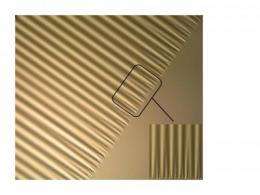Ironing out the causes of wrinkles

As a sign of aging or in a suit, wrinkles are almost never welcome, but two papers in the current issue of Physical Review Letters offer some perspective on what determines their size and shape in soft materials.
Jiangshui Huang and colleagues at the University of Massachusetts, Amherst explore how wrinkles in a sheet adapt to an edge that prefers to be flat. They float a thin, rectangular film of common plastic (polystyrene) on water and compress the sheet along one direction to make folds.
In the middle of the film, competition between gravity (which prefers shallow, frequent ripples) and the energy cost of bending the film (which favors longer, higher folds) determine the height and frequency of the folds. Near the edge, however, surface tension forces the film to lie flat. Huang et al. show the film interpolates between these two limits by smoothly tapering from larger, undulating folds in the center to higher frequency ripples at the edge.
In a related paper, Douglas Holmes and Alfred Crosby, also at the University of Massachusetts, Amherst quantify the transition from soft wrinkles to sharper folds. Similar to lifting a tissue from a box, they pull up an elastic sheet floating in water, and image the sheet as first wrinkles, and then folds, appear. They show that folds, like the edges of a neatly made bed, strain the sheet and smooth out the wrinkles.
The experiments offer complimentary insights into how defects, such as an edge or a fold, influence the presence of wrinkles and could prove helpful in understanding the formation of wrinkles in biological tissue.
More information:
-- Smooth Cascade of Wrinkles at the Edge of a Floating Elastic Film, Jiangshui Huang, Benny Davidovitch, Christian D. Santangelo, Thomas P. Russell, and Narayanan Menon, Phys. Rev. Lett. 105, 038302 (Published July 14, 2010), link.aps.org/abstract/PRL/v105/e038302
-- Draping Films: A Wrinkle to Fold Transition, Douglas P. Holmes and Alfred J. Crosby, Phys. Rev. Lett. 105, 038303 (Published July 14, 2010), link.aps.org/abstract/PRL/v105/e038303
Provided by American Physical Society
















